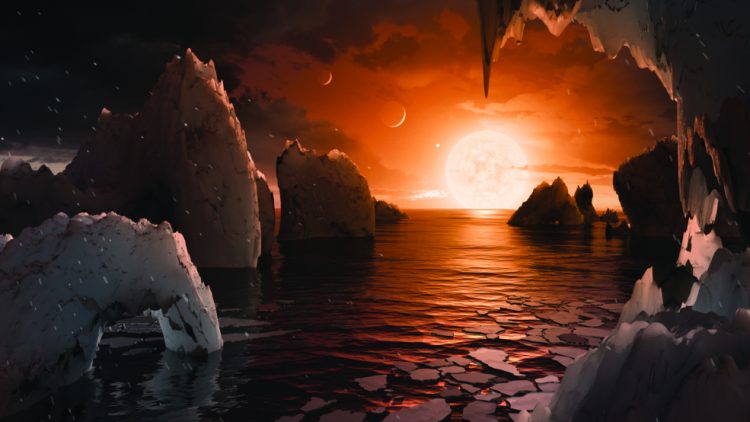NASA discovers seven Earth-like planets trillion miles away from Earth.
By Infinity Holloway
Contributing Writer

An artist’s interpertation of the possible surface Trappist-1, one of the newly discovered planets in the Trappist-1 system.
On Feb. 22, 2017, NASA officials announced the discovery of seven new Earth-like planets outside the solar system with the aid of the Spitzer Space Telescope.
The exoplanet system Trappist-1 is 235 trillion miles away from Earth, according to NASA. NASA scientists consider it to be only 40 light years away in the Aquarius constellation. The Trappist-1 system contains a star with seven unexplored planets surrounding it. According to NASA, three of these planets are firmly located in the exoplanetary system’s habitable zone. Habitable zones are areas most likely to have the key to human life: water. The discovery set a record for the largest number of planets found around a single star outside of the solar system, according to NASA.
In May 2016, the first three planets were discovered, according to CNN. In early February, researchers discovered four more, and the newest findings were published in the natural science journal Nature.
Anahita Sidhwa, astronomy and physics department chair, said, “I think it is natural for us as scientists to look beyond and go further and further and further away… It’s the human quest to find something else.”
NASA researchers discovered the Earth-like planets are rocky and tidally locked to the star they revolve around. The star is an ultra-cool dwarf, but the closeness of its surrounding planets still allows for their surfaces to stay sufficiently warm, thus placing them in the habitable zone.
Although the seven planets are Earth-like, there are some differences. These planets have varying orbits, and while standing on the surface of these planets, less light shines on the surface of the exoplanets because their star is cooler, according to CNN. Due to the nature of the planets’ star, more energy is transferred and provides warmth for living organisms.
“One of the things that we find when we discover new things is that things are unusual,” Sidhwa said. “And one of the unusual things about these planets is that the systems, the solar systems around these stars, are not like our solar system. Is our solar system the norm and these things are the abnormal thing or is ours abnormal?”
The next step for NASA researchers is to define the details of the planets’ atmospheres and determine whether water or any signs of life are present, according to CNN. There has been no discussion of physical exploration due to the Trappist-1 star being 40 million years away. The system is close enough to research and pursue further details about the other solar systems that exist.
“As far as the astronomy community is concerned, visiting another world is always going to be a goal whether it happens in our lifetime, or our children’s lifetime,” Sidhwa said. “But the last 30 years doesn’t bode very well [for the future.] I was in college when we landed on the moon and we haven’t returned since.”
Sidhwa said she is not conducting any personal study of the new planets, but the data from these discoveries is public information, and with the right education and equipment, it can be analyzed by anyone.






